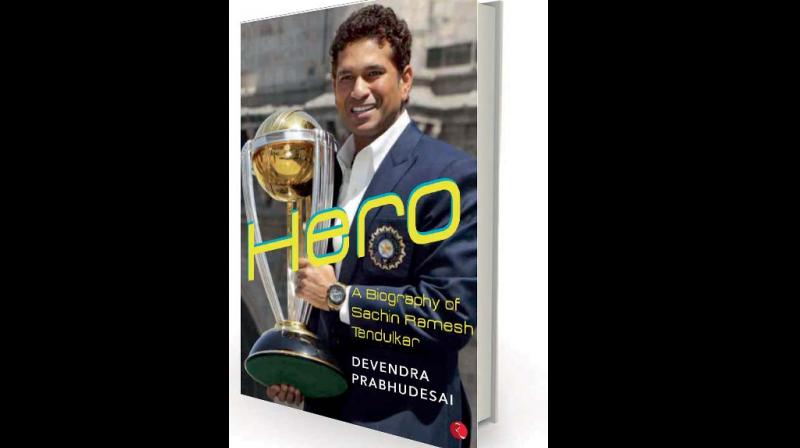Book Review 'Hero- A Biography of Sachin Ramesh Tendulkar: A brilliant record'

Sachin Tendulkar and India are joined at the hip. The persistent counterpoint to his steady climb to this current mid-career apogee has been the disappointment attending the performances of his struggling teammates. Next to the English, the Indians are the greatest underachievers in cricket. Leading an Indian team in a sustained run of international one-day and Test success, home and away, seems to be the single most glittering peak Tendulkar has yet to scale. The preconditions for his even attempting to reach that summit are his reappointment to the captaincy and a change of strategy on the part of the Indian cricket authorities… Whatever else happens, the second half of Sachin’s career is therefore likely to be even more challenging than the first,” Mike Marqusee, quoted in Hero.
In the event, this never came to pass. Sachin Tendulkar was indeed appointed to a second term as captain of India, but much like his first stint at the helm, it ended in a mixture of disappointment, and even some controversy. Leading a team that was a good mix of experience and young talent, the results never quite met the expectations. In Hero, Devendra Prabhudesai delves into this aspect, and more, of a remarkable career that blazed an almost nation-defining trajectory across the skies of Indian and international cricket.
It will remain one of Indian cricket’s enigmas — why Tendulkar the cricketer never fitted comfortably into the role of a captain. Leader he certainly was, in a career spanning 200 Test matches and 436 one-day internationals that cumulatively fetched 34,347 runs and a round 50 centuries at healthy averages, but his 25 Tests as captain brought only four victories, and 23 wins from 73 games as ODI captain. In Tendulkar’s own words, “I wanted it the first time and believed that I could make a success of it. But when I lost it, I did not think of it again. Let me make it clear that I did not want the job when it was thrust on me the second time… The second time around… I should have refused (the job) and spared myself unnecessary strain and hassles… I can’t be me when I am the captain… Other than this phase in my career, I have no regrets about any of my actions.”
Captaincy aside, the Tendulkar saga remains one that defined not just Indian cricket for over two decades, but the country itself in many ways, a coming-of-age. A tale of a cricketer who grew into promised greatness, and a nation that burgeoned as an idea in parallel. “Saachinn, Saachinn” was for 24 years the theme song of Team India and Indian cricket, built around a player and a person who almost never faltered under the great burden.
Prabhudesai follows a linear narrative, starting from the early years and ending with the double finale at the Wankhede Stadium, Tendulkar’s home ground where he was a member of the first 2011 World Cup-winning team and thereafter the drama and emotion-filled 200th and final Test farewell against the West Indies. It traces the early years of the prodigy from a solid, middle-class Marathi milieu that was to provide him with the bedrock of stability in a career that surpassed superstardom, through the highs and heartbreaks of a stellar career till its glittering finale.
Yet, for all his thousands of runs and inspirations presence over 24 years, Tendulkar’s greatest contribution to Indian cricket, and the sport in a wider context, came during the dark years of the match-fixing saga. At a time when disbelief and anger surrounded every result, win or lose, it was his unblemished presence, along with fellow stalwarts Rahul Dravid, Anil Kumble and Sourav Ganguly, that hauled Indian cricket back from the abyss, and helped turn cynics back into fans again.
Embers of that infamous time involving South Africa’s late captain Hansie Cronje and the Indian team of the 2000 Test series at home continue to smoulder even to this day, but it was thanks to this quartet and their immense stature and reputation in the game that gave Indian cricket back its respectability. In its interim report of October, 2000, the CBI said, “By early 1990s, betting on cricket had spread across India and attained a measure of sophistication… The introduction of mobile phones in the mid ’90s also gave a major fillip to this racket... Bombay emerged as the main center for betting, followed by Delhi and other metropolitan cities.”
The report also had this one line that was telling. “In fact, in most of the matches where fixing was taking place, the clue was that the game would ‘be on’ only when Tendulkar got out because he was one player who could single-handedly win the match and upset any calculation.” Sachin himself, said of that period, “Anybody who opens his mouth should also provide proof. It’s important not to create controversies. It’s the game that will suffer… It (cricket) has given so much joy to people all over the world, This is just a passing phase.”
The next 13 years too had ups and down, Sachin’s old injuries sometimes recurring — the inevitable transition from youth to seniority having its effect on his batting. Through it all, he carried on, one dream still burning bright — that of winning the World Cup some day like one of his idols, Kapil Dev, had done in 1983. All that was laid to rest on the night of April 2, 2011, when MS Dhoni lashed the winning six in Wankhede. There were wild celebrations, tears and Tendulkar was carried around the ground by his teammates to great acclaim.
Sachin Tendulkar’s spiritual successor, Virat Kohli, had the words to sum up the occasion, the man and his career. “Sachin Tendulkar has carried the burden of India for 21 years. It was time we carried him.”

